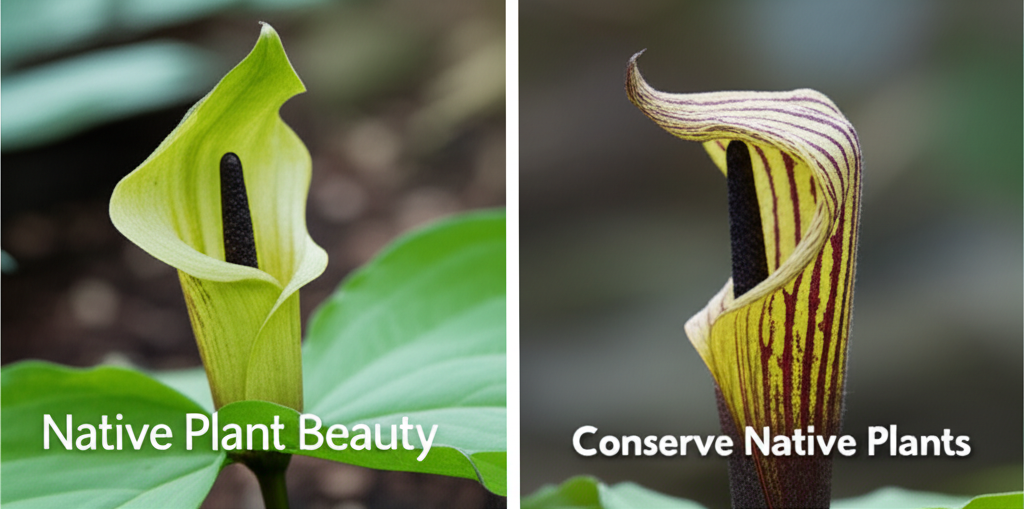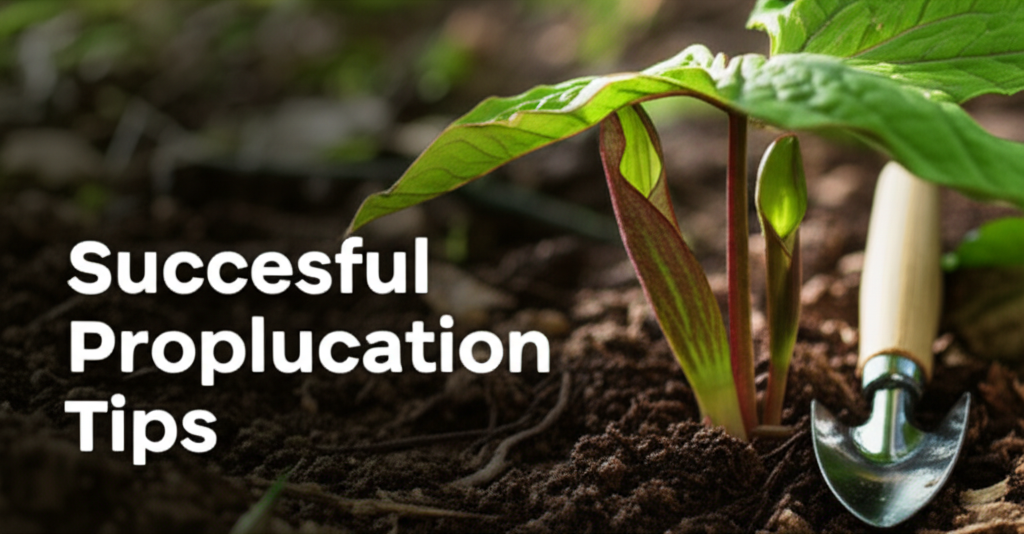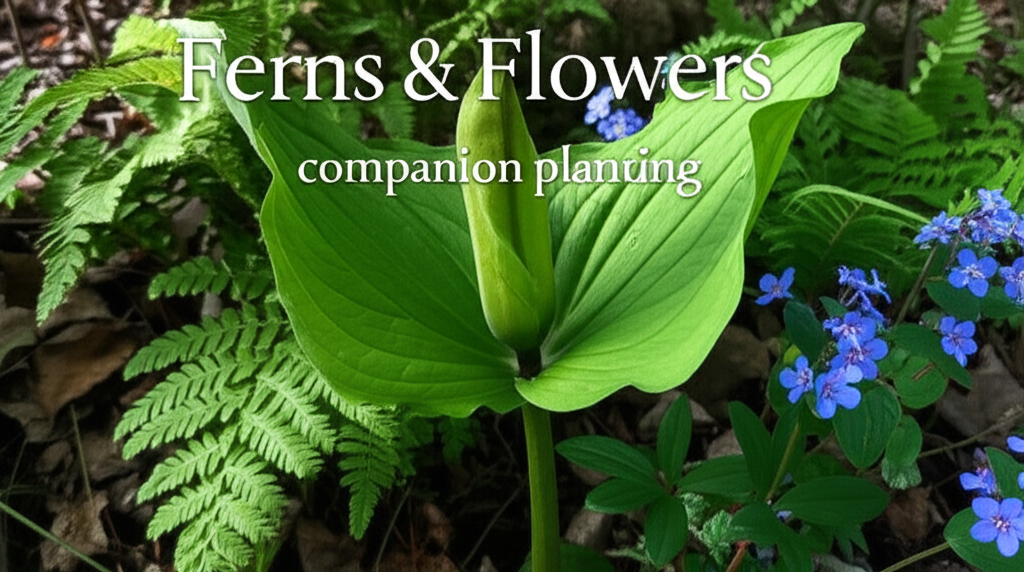Introduction: The Allure of the Jack-in-the-Pulpit
The Jack-in-the-Pulpit (Arisaema triphyllum) is a captivating woodland native, instantly recognizable by its unique hooded spathe and spadix, resembling a preacher in his pulpit. This intriguing perennial is a fantastic choice for small urban gardens seeking a touch of the wild and a dash of botanical curiosity. Its dappled shade requirements and relatively compact size make it adaptable to various microclimates found in city landscapes, from shady courtyards to understory plantings. Beyond its striking appearance, the Jack-in-the-Pulpit plays a vital role in supporting native insect populations and adds a distinct architectural element to the spring garden. This guide will delve into the art of propagating this fascinating plant, specifically tailored for the constraints and opportunities of small urban gardening. We’ll cover everything from understanding its life cycle to mastering seed and corm propagation techniques, ensuring you can successfully bring this woodland jewel to your own green haven.
Understanding the Jack-in-the-Pulpit’s Life Cycle

To effectively propagate Jack-in-the-Pulpit, a fundamental understanding of its growth habits and reproductive strategies is essential. These plants are herbaceous perennials, meaning they die back to the ground each year and regrow from an underground storage organ.
The Corm: The Heart of the Plant
The primary storage organ of the Jack-in-the-Pulpit is a corm. This is a swollen, underground stem that stores nutrients and water, allowing the plant to survive dormancy periods. Corms vary in size and shape and are crucial for both vegetative propagation and seed development.
Dioecious Nature and Flowering
A fascinating aspect of Jack-in-the-Pulpit is its often dioecious nature, meaning individual plants are typically either male or female, though some can be monoecious (having both male and female flowers) or even change sex over time depending on their size and environmental conditions.
- Male plants: Produce pollen and have a smaller spadix relative to the spathe.
- Female plants: Produce ovules and develop fruit if pollinated, and have a larger spadix relative to the spathe.
Flowering typically occurs in late spring, with the distinctive spathe unfurling to reveal the spadix. Pollination is primarily carried out by small flies.
Fruiting and Seed Dispersal
After successful pollination, female plants will produce a cluster of bright red berries in late summer. These berries are attractive to birds and other wildlife, which aid in seed dispersal. The berries contain seeds that are vital for sexual propagation.
Propagation Methods for Urban Gardeners
For the urban gardener with limited space, efficient and reliable propagation methods are key. Jack-in-the-Pulpit can be propagated through two primary methods: seed propagation and corm division.
1. Seed Propagation: The Long Game
Growing Jack-in-the-Pulpit from seed is a rewarding, albeit patient, endeavor. It requires mimicking the plant’s natural germination process and can take several years for a seedling to mature into a flowering plant.
Collecting and Preparing Seeds
- Timing: Collect seeds when the berries have ripened to a vibrant red and are slightly soft to the touch, typically in late summer or early fall.
- Extraction: Gently crush the berries to release the seeds. Wash the seeds thoroughly in a sieve to remove any berry pulp, which can inhibit germination.
- Stratification: Jack-in-the-Pulpit seeds require a period of cold, moist stratification to break dormancy. This mimics the winter conditions they would experience in nature.
Mix the cleaned seeds with a sterile, moist medium such as peat moss, vermiculite, or sand.
Place the mixture in a sealed plastic bag or container.
Store in the refrigerator (not freezer) for 3-4 months. Check periodically to ensure the medium remains moist and to watch for any signs of mold.
Sowing the Seeds
- Timing: After stratification, sow seeds in the early spring.
- Medium: Use a well-draining seed-starting mix. A good blend might include equal parts peat moss, perlite, and compost.
- Sowing Depth: Sow seeds about 1/4 inch deep.
- Location: Plant in small pots or seed trays. For urban settings, consider using recycled containers like yogurt cups or small plastic food containers with drainage holes.
- Environment: Keep the pots in a cool, shaded location, mimicking their natural woodland habitat. Consistent moisture is crucial but avoid waterlogging. A greenhouse or a sheltered cold frame is ideal, but a shaded windowsill can also work.
- Germination: Germination can be erratic and may take several weeks to months. Some seeds may not germinate in the first year.
Seedling Care
- Watering: Water gently to avoid disturbing the delicate seedlings.
- Light: Provide bright, indirect light. Direct sun will scorch young seedlings.
- Transplanting: Once seedlings have developed their first true leaves and are large enough to handle (usually after a year or two), they can be carefully transplanted into larger pots or directly into a prepared garden bed in a shaded area. Be extremely gentle with the developing root systems.
2. Corm Division: The Faster Route
Corm division is a more direct and often faster method for propagating Jack-in-the-Pulpit, especially if you have an established plant. This involves separating the offsets (smaller corms) that naturally form around the parent corm.
When to Divide
- Timing: The best time to divide Jack-in-the-Pulpit corms is in late summer or early fall, after the foliage has yellowed and died back. This is when the plant is entering its dormant phase, and the corms are easily accessible and less stressed.
The Division Process
- Careful Excavation: Gently dig around the base of the established plant using a trowel or small spade. The goal is to lift the entire clump without damaging the corms.
- Locate the Corms: Once the clump is out of the ground, you will see the main corm and several smaller cormels (offsets) attached to it. These cormels are the key to propagation.
- Separation: Carefully twist or cut the cormels away from the parent corm. Ensure each cormel has at least one small bud or eye, which is essential for regrowth.
- Inspection: Inspect the corms for any signs of rot or disease. Discard any unhealthy-looking corms.
- Replanting:
For immediate planting: Replant the divided corms directly into your garden bed or pots.
* For later planting: If you intend to plant them later, store the divided corms in a cool, dry, and well-ventilated place (like a paper bag filled with peat moss or vermiculite) until ready to plant in the fall.
Replanting Divided Corms
- Location: Choose a shady or partially shady spot with moist, well-draining soil rich in organic matter.
- Depth: Plant the corms about 3-4 inches deep, with the bud or eye facing upwards.
- Spacing: Space them at least 6-8 inches apart to allow for growth.
- Watering: Water thoroughly after planting.
Key Facts and Comparison of Propagation Methods
Understanding the nuances of each propagation method will help you choose the best approach for your urban gardening goals.
| Feature | Seed Propagation | Corm Division |
|---|---|---|
| Time to Flowering | 3-5 years (or longer) | 1-2 years |
| Effort Required | High (requires patience, stratification) | Medium (requires careful excavation and separation) |
| Number of Plants | Potentially many from a single harvest | Limited by the number of offsets on the parent plant |
| Genetic Diversity | High, resulting in potentially new variations | Low, resulting in clones of the parent plant |
| Success Rate | Variable, can be low due to germination challenges | Generally high if done correctly |
| Ideal for | Experimentation, increasing plant numbers, creating variations | Quickly expanding existing plantings, ensuring true-to-type plants |
Step-by-Step Guide: Propagation Success in Small Urban Spaces
Navigating the propagation process in a confined urban setting requires strategic planning and adaptation.
Preparation is Key
- Assess Your Space: Identify suitable shady spots, balconies, or patios where Jack-in-the-Pulpit can thrive. Consider container gardening if in-ground space is limited.
- Gather Supplies: Ensure you have appropriate pots, well-draining potting mix, sterile tools, and a reliable source of water. For seed propagation, a small propagator or seed tray with a clear lid can be beneficial.
The Propagation Process: A Visualized Walkthrough
Seed Propagation Steps:
- Berry Collection: In late summer, gather ripe red berries.
- Seed Cleaning: Crush berries and thoroughly wash seeds to remove pulp.
- Stratification: Mix seeds with moist medium, seal in a bag, and refrigerate for 3-4 months.
- Sowing: In spring, sow stratified seeds (1/4″ deep) in pots with seed-starting mix.
- Germination: Maintain consistent moisture and shade. Be patient; germination may be slow.
- Seedling Care: Provide indirect light and gentle watering.
- Transplanting: Once seedlings are established (1-2 years), transplant them to larger pots or garden beds.
Corm Division Steps:
- Dormancy: Wait until late summer/early fall when foliage has died back.
- Excavation: Gently dig up the parent plant clump.
- Corm Separation: Carefully detach cormels (offsets) with visible buds from the main corm.
- Inspection: Discard any damaged or diseased corms.
- Replanting: Plant corms 3-4″ deep in a shady, moist, well-draining location.
- Watering: Water thoroughly after planting.
Pros and Cons of Each Method for Urban Gardeners
Every gardening technique comes with its own set of advantages and disadvantages, especially within the context of limited urban space.
| Method | Pros | Cons |
|---|---|---|
| Seed Propagation | Economical for producing large numbers of plants over time. | Takes a significant amount of time (years) to reach maturity. |
| Introduces genetic diversity, potentially leading to unique plant traits. | Germination can be unreliable and requires specific stratification techniques. | |
| Corm Division | Faster results, with plants typically flowering within 1-2 years. | Limited by the number of offsets available from existing plants. |
| Ensures plants are genetically identical to the parent, guaranteeing desired characteristics. | Requires careful handling of corms to avoid damage. |
Tips for Success in Small Urban Gardens
Adapting propagation techniques to urban environments requires a mindful approach to space, resources, and microclimates.
Container Gardening Advantages
For many urban dwellers, container gardening is not just an option but a necessity. Jack-in-the-Pulpit is well-suited to containers, provided they offer adequate depth and excellent drainage.
- Pot Size: Choose pots that are at least 8-10 inches deep to accommodate the corm and root growth. Larger pots are even better.
- Soil Mix: Use a high-quality, well-draining potting mix enriched with organic matter. A blend of potting soil, compost, and perlite or coarse sand works well.
- Watering: Container plants tend to dry out faster than in-ground plants. Monitor moisture levels diligently and water as needed, especially during dry spells.
- Location: Place containers in areas that receive dappled shade throughout the day. Balconies, patios, and north-facing window boxes are ideal.
Maximizing Shaded Spaces
Urban gardens often present unique shading challenges and opportunities.
- Understory Planting: Utilize the shaded areas beneath trees or taller shrubs. This mimics the natural habitat of Jack-in-the-Pulpit.
- Building Shade: Leverage the shade cast by buildings, fences, or trellises. Be aware of how the sun’s angle changes throughout the season and how this impacts light availability.
- Companion Planting: Combine Jack-in-the-Pulpit with other shade-loving plants like ferns, hostas, or woodland wildflowers to create a lush, layered planting scheme.
Soil Amendments and Moisture Retention
Healthy soil is the foundation of successful plant growth, especially for woodland natives.
- Organic Matter: Incorporate generous amounts of compost, leaf mold, or well-rotted manure into your planting beds or potting mix. This improves soil structure, drainage, and nutrient content.
- Mulching: A layer of organic mulch (e.g., shredded bark, wood chips, or leaf litter) helps retain soil moisture, suppress weeds, and regulate soil temperature. This is particularly beneficial for corms stored over winter or for seedlings.
Troubleshooting Common Propagation Issues
Even with the best intentions, challenges can arise. Here are some common problems and their solutions:
Problem: Seeds Not Germinating
- Possible Cause: Insufficient or improper stratification, old seeds, or incorrect sowing conditions.
- Solution: Ensure seeds have undergone a full stratification period. Use fresh seeds. Verify correct sowing depth and consistent moisture and temperature. Some seeds may simply be non-viable.
Problem: Corms Rotting
- Possible Cause: Poor drainage, overwatering, or planting corms too deep in excessively wet soil.
- Solution: Always use well-draining soil. Ensure pots have drainage holes. Plant corms at the correct depth. Allow the soil to dry slightly between waterings.
Problem: Seedlings Stunted or Dying
- Possible Cause: Too much direct sun, overwatering, underwatering, or lack of nutrients.
- Solution: Move seedlings to a shadier location. Adjust watering schedule. Ensure the soil is consistently moist but not waterlogged. Once true leaves appear, a very dilute liquid fertilizer can be applied, but err on the side of caution.
Conclusion: The Rewarding Journey of Cultivating Jack-in-the-Pulpit
Propagating Jack-in-the-Pulpit, whether through the patient journey of seed or the more immediate reward of corm division, offers a deeply satisfying gardening experience. For those with limited urban space, these methods are not only feasible but can be remarkably successful when tailored to the unique conditions of city gardens. By understanding the plant’s life cycle, embracing the appropriate propagation techniques, and adapting them to container gardening and shaded urban pockets, you can bring the captivating beauty of the Jack-in-the-Pulpit to your own patch of green. The effort invested will be repaid tenfold by the unique visual appeal, ecological contribution, and sheer botanical intrigue this remarkable native perennial brings to your small urban oasis. Happy propagating!



